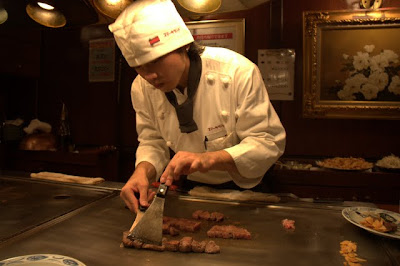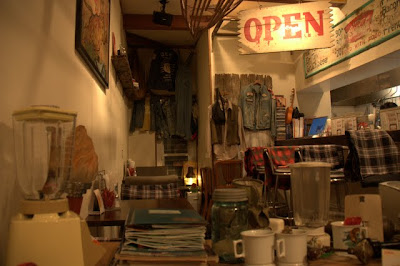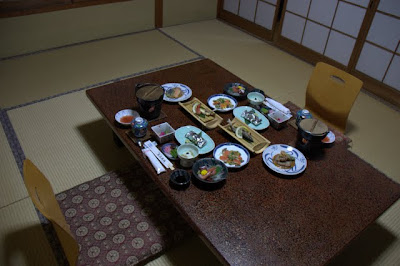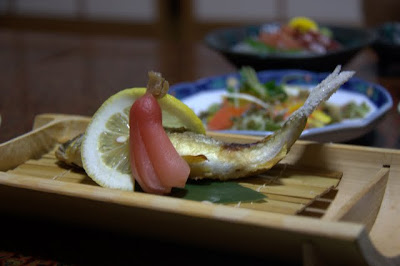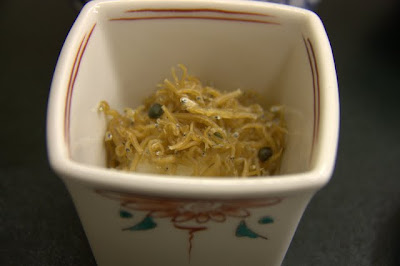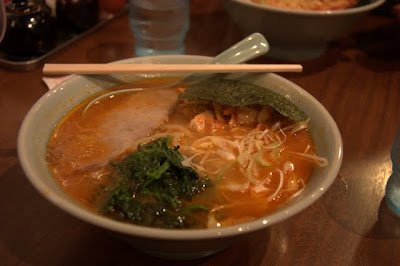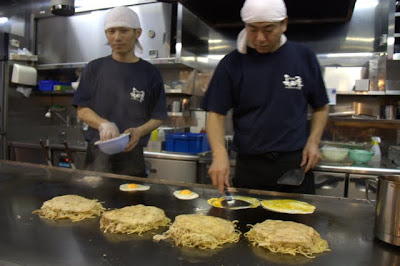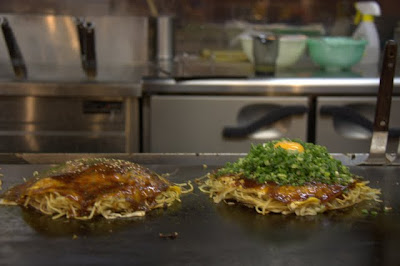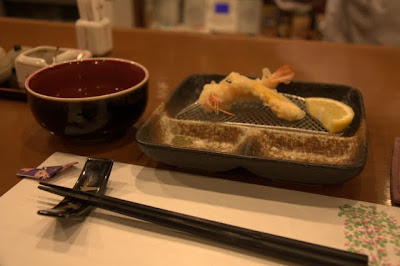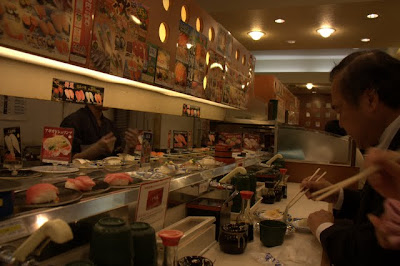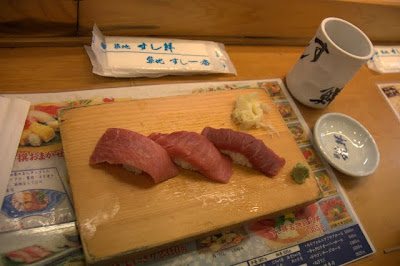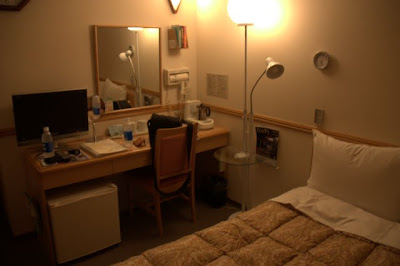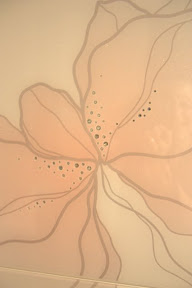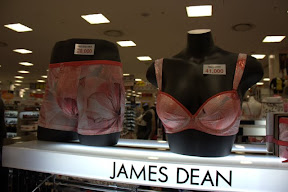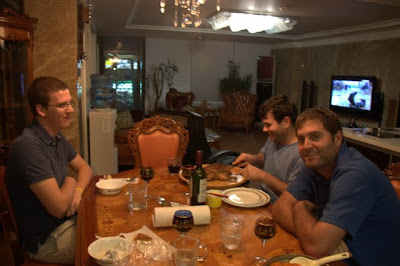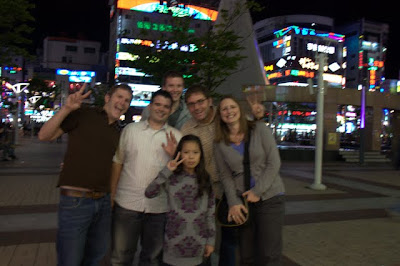Adventures in Eating in Japan, Part Two
Undoubtedly, eating in Japan is a big part of the adventure of traveling through the country. Yesterday, I shared five of our most memorable meals during our Japanese travels. Here’s another five to finish up the list:
Budget Buster
Knowing that we are headed to India next, where the cow is sacred, and being less than an hour train ride away from Kobe, we decided to splurge on the infamous Kobe beef in Kobe. Allegedly, to get the Kobe beef designation, cows are bottle fed beer and massaged. I never could get a straight answer on whether this is true, but for the price we paid, let’s all pretend that it is. The Kobe beef label is slapped on every expensive piece of beef back home, but apparently in Japan it just means quality beef that comes from one specific area in Japan. My research indicated that Kobe beef can be somewhat hard to find in Kobe, but The Google led us to Steakland Kobe, located close to the train stations. Steakland Kobe reminded me of American Japanese steakhouses more than any other place at which we ate in Japan. We took seats around a grill and watched the grill master slice up the raw beef and cook it before us. Before you even eat it, you can tell that the beef is going to be incredibly rich from the intense marbling. In the end, we’re not sure that we were big fans. Naturally, they charge insanely high prices for Kobe beef in Kobe – our meals were a whopping $143! I’m not sure if it was the crazy high price we paid or the super beefy taste that made us disappointed, but within 45 minutes of entering the restaurant, we were back standing back on the streets of Kobe, trying to make ourselves feel better about our budget-busting meal, saying, well, I guess it was worth it just once, right? Right?
Mmmm….burgers
Our second foray into Japanese beefland was a little more budget friendly. You can get burgers all over the world, but most of them are sorry, greasy imitations of the burgers you can get back home. Who would have thought that we would find one of the best burgers of the trip in Takayama, a small (and adorable!) town in the Japanese Alps? It is rare, but sometimes some of the best meals in a country are not the native cuisine. (I’m remembering you, delicious Italian anniversary meal in Prague). Wanting to take a break from noodles and the like, we decided to check out Center 4 Hamburgers one night. The shop is decorated in an Americana country-western theme, which right there transports you far away from Japan. The burgers were juicy and flavorful, the cheese was actually cheddar, the tomatoes ripe and fresh, the fries were crispy, and, best of all, they had Heinz ketchup. Sean still maintains that our Irish beef burger in Donegal, Ireland is the trip’s best burger, but I think this burger in Takayama is a strong contender.
Big Apples
While we struck out on seeing lots of koyo (autumn leaves), the best part of being in Japan in the fall was the apples. Once we got over the sticker shock of paying a couple of dollars per apple, we ponied up the money to try them. The apples in Japan are huge, juicy and sweet. As we were eating Fuji apples in Hakone, a town with views of Mt. Fuji on a clear day, it suddenly occurred to me where Fuji apples got their name. Duh.
The Japanese seem to be very particular about their apples. Most places, even roadside stands, wrap the apples individually in styrofoam netting. When we pursued the apples to find a small one we could afford, the woman selling them kept repeating in broken English, hai, hai, find a good one. No bruises.
Organic yumminess
I am drawn to any organic restaurants, cafes, or shops I see on the road like a fly is drawn to honey. We came across two in Japan, and both were tasty treats. My favorite was Myogaya, a little homey place in Takayama. It took forever to get our food because it was made from scratch by the owner. I thought it was worth the wait. The brown rice was a nutty diversion from the bucketloads of white rice we’d been consuming, and it was fun eating the variety of little organic dishes on my plate.

As I think the first two mentions in this post shows, I could never fully commit to vegetarianism, but I like to dabble in vegetables from time to time. The organic veggie platter at Myogaya.
Meals that Look Back at You
A quintessential Japanese experience is staying at a ryokan, a traditional Japanese inn where you receive impeccable service, sleep on the floor on futons, walk around in slippers, and bathe at the inn’s onsen. We stayed at Kamesei Ryokan in Chikuma City, located in the Nagano Prefecture in the mountains. While the inn turned out to be a little more dated and less rural than we thought, the service from Tyler, an American, and his Japanese wife and in-laws was fantastic, and our meal was a great experience. We were served dinner on a low table in our room. We sat on the floor to eat, as Tyler paraded in dish after dish after dish. Our table was covered with little dishes by the time he was done, and he took the time to explain them all to us. The next morning, we had breakfast in a similar fashion. It was fun sampling all different kinds of Japanese food in one meal. After several weeks in Japan, we even felt brave enough to sample one of the dishes containing little tiny squid, with their little beady eyes staring back at us.
Adventures in Eating in Japan, Part One
All of our meals in Japan proved to be an interesting experience. Some of the food is familiar, like sushi, teppanyaki, or ramen, but most of it is never exported off the islands. The problem with Japanese food is that you never know what you are going to get.
Some of it is just so foreign to our American palates that we were fearful each time we ordered that we were getting something totally weird. If you are lucky, you will get a menu with awkward translations into English. More often, you had to rely upon photographs of the food on the menus or the plastic replicas in the window, which usually made things look rather unappetizing.
We never ended up ordering anything too out of the ordinary, but did end up with some tasty meals. Here are our ten most memorable meals from Japan, in two parts:
Not your college ramen
Although my college friends subsisted off a diet solely composed of ramen, I never was that big of a fan. Perhaps it was because the college ramen was always a weak broth and a couple of wimpy noodles. Fukuouka, our first stop in Japan, is known for their ramen noodles. We tried it twice while we were there: once at a yakatori (a street stall) and once at Ramen Stadium, a whole floor on the top of a shopping mall devoted solely to ramen noodle restaurants, each featuring ramen from different regions around Japan. Ramen is a good value: filling, but cheap by Japan standards. Our favorite was the kind with red broth, which we think is from Northern Japan, but who can be sure. We’re just lucky that we actually selected ramen noodles, considering we had to order it from a vending machine that was entirely in Japanese.
Everything but the kitchen sink
Another “cheap” but unique experience was eating okynamiyaki. We first tried it in Hiroshima, where it was prepared right in front of us on teppan grills. Since we were in Hiroshima, the okynamiyaki was prepared Hiroshima style, meaning each ingredient is layered on top of the other. (We later tried it Osaka style in Kyoto, where all of the ingredients are mixed together. We preferred the Hiroshima approach). While we watched, the grillmaster cooked the okynamiyaki in stages: batter, egg, pork, sprouts, noodles, brown sweet-soy sauce, corn, and cheese. They were tasty and uniquely Japanese, but somewhat rich so we only had them a few times.
CoCo Curry regulars
It is safe to say that I enjoyed the food in Japan more than Sean, probably because it is heavily seafood based. Sean was always on the lookout for something more familiar. His favorite place to eat was CoCo Curry House, a chain in every city serving Japanese curry. Japanese curry is much milder than other Asian curries, although we never got more than a 2 spice level since each spice level was an additional cost. His favorite dish was a crispy breaded chicken curry dish served with rice. At around $25 USD for two curry meals and salads, CoCo Curry House was a good bargain. At the Tokyo location near our hotel, two sumo wrestlers were chowing down, so we figured they agreed.
Light and crispy
Trying to find someplace to eat one night in Kyoto, we wandered into a little neighborhood restaurant called Tempura Arima near our hotel. The prices were on the high side, but it looked good so we decided to stay. There were only six people in the restaurant: us, a Japanese couple, a husband cooking and a wife serving. The four customers took up almost all of the stools at the bar. Their specialty was multi-course tempura meals, so that is what we ordered. Each course was artfully presented, with delicate tastes. Despite the limited words we had in common, we managed to have a conversation with the Japanese owners and customers. They seemed to get a kick out of us maneuvering with our chopsticks and trying new things, and the other customers bought us shots of sake.
Going Raw
Ah, sushi. High end or low end, the sushi in Japan never disappointed and often was the one thing that was cheaper in Japan than it was at home. Although I shy away from wasabi at home, I found myself not only eating but enjoying the wasabi in Japan, prepared with fresh locally grown horseradish. My favorite fish was the tuna. If it was the good stuff – and most of it was – it was deep crimson in color and tasted so tender it was like it already had been cooked.
Among other places where we tried it, we ate sushi at a conveyor belt restaurant in Tokyo. The sushi keeps on rolling by. You pick what strikes your fancy and they tally up your plates at the end.
On our last full day in Japan, we wandered around Tokyo’s famous Tsukji Fish Market where the fish doesn’t get any fresher, then had sushi for breakfast at a nearby restaurant. Yum. For a good overview of how to eat sushi in Japan, check out Mary in Japan’s post on sushi etiquette.
Taking Back Tea Time in Japan
My good friend Danielle, a tea aficionado and owner of the organic tea company Tupelo Honey Teas, started a campaign to take back tea time. Danielle’s idea is that everyone should take a little part of the day just for you and your favorite tea.
Having shed most of the stresses of everyday lives for a while, one could describe this entire year as one big long tea time, but even travel is stressful in its own way so we look for opportunities to decompress when we can. Taking back tea time is pretty easy in Japan; tea regularly comes with meals and EVERYTHING is green tea flavored. Breads, ice cream, rice balls, all kinds of sweets, even Kit Kats are flavored with matcha, a green powdered tea. But we wanted to take back tea time right, so while we were in Kyoto, we headed to Ippodo, said to be the oldest tea company in Japan.
Sean selected a duo of matcha, a green powder that results in a frothy tea when stirred with a whisk, and hojicha, a brown roasted tea.

I chose sencha, a grassy green tea.
We learned the proper way to prepare the teas, and Sean even mixed up his own matcha.

I’m still easing my way in to the world of tea, but tasting tea around the world has taught me two things: (1) properly prepared loose tea definitely tastes better than a bland tea bag dumped into a cup of hot water and (2) there is no reason to mess with regular old chocolate Kit Kats.
Sayonara to all our yen
[Editor’s note: Thanks for sticking with us while our access to internet was not up to snuff. I wrote lots of posts and processed tons of pictures, now I just need to get them uploaded. I’m hoping for some wifi in one of our rooms soon (wishful thinking) but I’ll do what I can with slow connections at internet cafes in the meantime, so stay tuned and please excuse me if I jump around a bit in the posts].
Japan was everything everyone said it would be: orderly, cutesy, polite, crowded, and expensive. Oh, was it ever expensive. We set a $200 a day budget for most developed countries we planned to visit. While normally we ended up being way under that amount, Japan was the first country where we had trouble sticking to the budget. To make matters worse, the value of the dollar kept dropping against the yen while we were there. It started at 83 yen to 1 USD, but dropped to 81 yen to 1 USD by the end. I suppose it negated any advantage we garnered from the weak euro while we were in Europe. If we hadn’t already committed to a three week railway pass and bought a plane ticket out of Tokyo to satisfy Japan’s proof of onward travel requirement, we would have left sooner. I enjoyed our time in Japan, but my enjoyment was tempered with ever-present concerns about our budget in the back of my mind.
(By the way, we were required to show our proof of onward travel when we entered Japan at the Fukuoka ferry terminal. We thought about trying some ways around the onward travel requirement, but since we already bought our rail pass, we bought our flight as well).
In the end, we ended up spending an average of $180.17 USD a day for both of us, not including transportation to and from overnight destinations. When that is added in, our costs were closer to $230. Keep in mind that our travel style is to travel as comfortable as we can at a budget level, so we occasionally splurge on things, eat out for almost all of our meals, and try to stay in private en-suite rooms.
To give you a sense of what you get for your money in Japan, here is a breakdown of the major expense categories:
Transportation:
I know one thing: you get what you pay for. Train travel in Japan is fabulous.
We rode the rails all around Japan, taking full advantage of our Japanese rail pass. (To read more about the logistics and costs of the rail pass, check out The Road Forks’ fantastically detailed post. In fact, while you are over there, check out all of their posts about Japan, especially their food posts breaking down Japanese eats with delicious photos). There is no need to upgrade to the first class green car; even the regular cars have tons of leg room and space for luggage. As someone who is perpetually trying to overcome my deep-ingrained bad habit of lateness, the oh-so-punctual trains blew my mind. The train stops were timed to the minute, meaning we relied upon the arrival time instead of trying to find the station name when getting off the trains. The trains zoomed around from city to city, making almost the whole country accessible by rail, and quickly. But all of this fabulousness comes at a price; it cost us $1500 for two three-week rail passes. We originally tracked the prices of the train trips we took, but stopped when we realized the passes paid for themselves only a week and a half into their use. We occasionally had to supplement our travel costs with local non-JR trains, but they usually were no more than the cost of a subway.
Speaking of subways, those too were more expensive than other major cities, such as Seoul. Part of the problem in Tokyo is that there are two different entities running the lines, meaning that sometimes you had to pay for two tickets to get the whole way where you were going. Since Tokyo is so big, it doesn’t really matter where you stay, but try to stay in walking distance to both lines to minimize costs. If you can’t do that, I’d choose something near the Tokyo subway line, since most things you’ll probably want to see fall on the Tokyo lines.
Accommodation:
We quickly learned that you don’t get a lot for your money in Japan. It wasn’t out of the question for a private room in a hostel with a shared bath to be nearly 8,300 yen (about $100 USD), although ones in the 6,225 yen (about $75 USD) range exist. Hostels tend to be Japanese style, meaning that you sleep on futons on a tatami-mat covered floor and take your shoes off at the front door. Dingy rooms, unpleasant smells, and shared bathrooms are common, but luckily so is free wi-fi.
We found business hotels to be a better value than hostels in the cities. Business hotels have plain, basic, boring rooms with the same exact features that all look exactly the same – the type of unimaginative hotel room I hate when on vacation but appreciate for its consistency on the road.
In Japan, a business hotel generally will get you a pretty small but clean room with fast hard-wired internet, a flat-screen television with one or two English speaking channels, decently cheap coin laundry, a refrigerator, a plastic pre-fab en-suite bathroom complete with a fancy electronic toilet, free Japanese breakfast, a cold filtered water dispenser in the lobby, and a hard double bed with strange beanbag pillows.
Toyoko Inns are ubiquitous throughout Japan’s cities. Since we ended up spending a fair amount of time in Kyoto and Tokyo, we bought a Toyoko Inn membership for something like $18 USD. The membership gets you 30% off on Sundays and holidays, 20% off on Mondays, and a free single room after 10 nights. If you opt to not have your room cleaned every day, you can also save 200 yen per day for certain days. (Be forwarned that on days you do have your room cleaned, the staff get very upset if you don’t leave your room between 10 and 2, the cleaning hours. We learned this the hard way). Depending on when your stay falls, the rooms can work out to be pretty cheap for Japan even with the cost of the membership. For us, after factoring in all the different type of discounts and membership fee, the average cost per night for our 8 nights in Kyoto and 9 nights in Tokyo was about 6469 yen (about $77.94 USD).
Food and Drink:
Food and drink is another category where Japan can empty your wallet if you are not careful. Unlike some other countries where we have travelled, the Japanese are great with promptly refilling your ice water at restaurants. This is a good thing because we mostly couldn’t afford to drink anything else. Soft drinks were typically about 400 yen (close to $5 USD) in restaurants, making them cost-prohibitive. Sean occasionally splurged and got Cokes out of the vending machines, where a can could be bought for 100 to 150 yen ($1.20 to $1.80). Beers were even worse. A Japanese beer like Kirin, Sapporo, or Asahi, was usually 600 or 700 yen in restaurants and bars ($7.22 to $8.43 USD), making Japan mostly a dry month for us. One night, we splurged in Tokyo and visited Baird Brewing’s taproom, which is a bar featuring the beers of the Japanese microbrew. The beers were great – probably the best we’ve had since Europe – but the whopping 900 yen for a pint was hard to stomach. That’s almost $11.00 USD! At least it turned out that it was for charity. The night we visited, Baird Brewing donated 100 yen for every drink purchased to Room to Read, a charity donating books to children in impoverished African and Asian countries. If you want to get your drink on, vending machines are where it is at – there, a can of beer is 300 yen ($3.61 USD).
One of the problems with budget travel in Japan is the temptations around every corner. Japanese food was tasty for the most part, but it is very foreign to our American palates, making us susceptible to influences. The Japanese love high-end status items, and this includes food. For example, although Japan is a tea drinking nation, they are very into coffee, especially of the iced variety. The multitude of Starbucks proved to be too tempting to us, especially for Sean the coffee lover. We tried to stay away, but dropped 420 yen (over $5) on coffee too many times. We also tried the local coffee chains, but those weren’t priced any better.
For my part, the sweets were the culprit. No matter how many times I told myself not to succumb to the chocolate cake behind swanky department store counters or in trendy cafes because it just didn’t taste right, I did it anyway. And I had been counting down the days to Tokyo since we finished the Pierre Marcolini chocolate I bought in Belgium. My research had revealed that Pierre Marcolini is sold in Japan, but what I didn’t know was that it was priced over four times as high as it was in Belgium. Four times! It was a sad, sad day when we visited the Ginza Pierre Marcolini store and I learned that the $7 gourmet tablets of chocolate I bought in Belgium were priced at $28. While the Japanese around us walked out with bagfuls, I resigned myself to eating one tiny $4 piece, delivered to me in an elaborate box even though I could have popped it in my mouth right then and there and saved everyone a lot of trouble. I stretched it for as long as I could to get my $4 worth, but couldn’t make it last more than two bites.
But of course, you need more than overpriced coffee and chocolate for substance. If a lunch or a dinner was $25, we considered that to be a bargain in Japan. My favorite “cheap” place to eat was the bottom floor of department stores. There, you will find counter after counter of prepared food. It can be a sensory overload, because the options are endless (Noodles? Gyoza? Sushi? Fried chicken? Salads? French food? Chinese food? Thai food? Dessert?) The female counter clerks call out in a sing-songy high-pitched voice in Japanese trying to entice you to their counter. The bento boxes, designed to be a portable meal on trains, were usually the best value. My favorites were the different Japanese salads, gyoza, sushi rolls, or Thai spring rolls.
We also saved money because breakfast was included in the price of most of our rooms. While I can never get used to the idea of eating savory dinner items for breakfast, and while we got sick of eating the same meal over and over, the rice balls and toast at the Toyoko Inn’s included breakfast was filling and prevented us from dropping $17 USD on coffees and muffins at Starbucks or other cafes.
In the end…
…I still think Japan is worth a visit. You just need to be mindful of your costs while you are there. If we had to do it over again, we would have spent only 2 or 3 weeks in the country and got a 14 day rail pass. Japan is just too expensive to dawdle on a trip like ours, and because of the efficiency of the railways, you can hit a lot in two weeks. We spent a lot of time in Tokyo and Kyoto – over a week in each – which definitely could be cut down. We had planned to do a lot of day trips from Kyoto, but didn’t end up making any of them except one half day to Kobe because of various reasons (rain, migraines, etc.) We got a little bored in Kyoto, but not in Tokyo, so it is all personal preference, I suppose. Even if you are not normally a planner, be organized and efficient like the Japanese and plan your trip before you enter the country to maximize your time and money. Hyperdia.com will be your best friend. It is a great tool that allows you to access the train schedules for all companies in English. There is a lot to see in Japan, so just decide what appeals to you the most – the cities, the “countryside” (to the extent there are rural areas in Japan; the “rural” areas we visited ended up being mostly smaller, low-key cities); mountains; temples and shrines; historic Japan; or modern Japan.
15 Important Cultural Lessons That You Can Learn From Just One Week in Changwon
We didn’t originally plan to travel to South Korea. But then our friend Kevin ended up in Changwon, a city in southwest South Korea, for four months for work. The timing worked out that we could make a quick trip to South Korea to visit Kevin before we travelled to Japan. We always jump at the chance to visit friends and more important, mooch off them as much as possible (Kevin is actually the brother of our friend Matt, who we visited in Paris when he was sent there for work early in our trip).
Changwon isn’t necessarily a place you would visit as a tourist. Next to the American navy base, Changwon was planned to take over as the capital if something happened to Seoul. There are a fair amount of expats and visiting Americans living in Changwon, due to the high concentration of industry present. If you are American and you are in Changwon, you are either in the military, an English-as-a-second-language teacher or an engineer sent over by an American company for work.
Kevin fell into the latter category. Staying with friends who are travelling on the man’s dime isn’t half bad; Kevin’s employer was putting him up in an enormous three bedroom, two bath apartment, so we not only got our own room (complete with pink fluffiness and stuffed animals) but also our own bathroom.
The apartment was rather pimped out, with laundry (yay!), a huge television, crystal chandelier, massage chair, and a bedazzled refrigerator. Yes, you read that correctly. The refrigerator was bedazzled.
We spent Chuseok, the Korean thanksgiving holiday, in Changwon. Kevin had off from work all week, so we spent lots of time lazing around Kevin’s apartment, watching NCIS (apparently Koreans love this show, because it was on in an endless loop), eating Mr. Pizza (a Korean pizza company located nearby who has love for women), and periodically venturing outside to go to Lotte Mart (a Korean grocery/department store).
Lest you think we didn’t learn about South Korean culture during our lazy week in Changwon, I present to you the following fun facts about South Korea:
- South Korean couples are so matchy-matchy and lovey-dovey, they even coordinate their underwear.
- Flavored soju, a South Korean rice wine, tastes much, much better when it is Kool-Aid flavored.
- There are call buttons at tables in Korean restaurants. When you press the button, if you call out “so-ju” in a sing-songy voice, soju will arrive on demand.
- At Korean barbeque restaurants, it is possible to receive and give a massage from your waitress, as long as you share your soju with her.
- Koreans love gadgets. Every taxi driver has a GPS that is probably bigger than your television set.
- Changwon might be the brightest place on earth.
- When receiving a drink or filling the glass of your elders, you must use two hands. You cannot fill up your drink glass, but don’t worry, as soon as it is empty someone will fill it back up. If you don’t want to get drunk, you better nurse your drink.
- If you can’t find a bar, look up. Bars are located in second or third floors in dingy office buildings, complete with squat toilets in the bathroom.
- If you request American rock’n’roll at a bar playing music videos, they will play Thunderstruck by AC/DC, complete with clips of war footage and fighter jets that would make Maverick proud.
- No matter where you order pizza from in South Korea, it comes wrapped in a bow.
- It is perfectly acceptable to blow through a red light, but don’t you dare turn left unless you have a green arrow.
- The workers at the Changwon Cold Stone like it, love it, and gotta have it more than their American counterparts.
- If you shop at Lotte Mart around closing on Choesok, they will blare classical music at top volume to get you out of the store.
- It may not be possible to find turkey for your Choesok feast, but Lotte Mart does carry chicken (although, as it turns out, ones with orifices too small to insert a can of Hite for beer-can-chicken).
- The peace sign is alive and well in Changwon, and being taught to the South Koreans at a young age.

